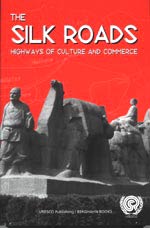The Silk Roads - Highways of Culture and Commerce

- © Unesco
Towards the middle of the 20th century, scholarly research revealed that the fabled Silk Roads, far from being mere trade routes, were cultural highways that played a pivotal role in linking East and West, intermittently bringing together nomads and city dwellers, pastoral peoples and farmers, merchants and monks, and soldiers and pilgrims. The notion of movement is therefore central to an understanding of the relations between peoples; it is also the factor of which specialists have, for various reasons, not taken sufficient account.
It is in this context that the Silk Roads Project, initiated by UNESCO, assumes its significance. It has proved very fruitful and led to a large variety of projects of which this volume presents a selection. Although the papers collected here are wide ranging, they reveal the emergence of the concept of a common heritage and plural identity. The studies carried out under the Project have shown that identity, seen from a long-term perspective, cannot be viewed as a ghetto or an enclosure, but as the result of whole process of synthesis and encounter between peoples and cultures.
- Publication Date: 15-04-2008


